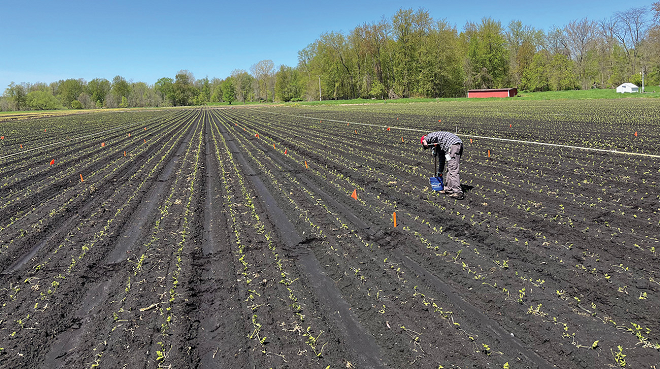

Aug 18, 2023Comparing nitrogen management technologies
Nitrogen (N) is the nutrient most likely to rob high demand vegetables of yield. But when supplied in excess, it can also reduce produce quality, erode farm profits and harm the environment.
Fertilizing enough, but not too much, is an age-old challenge. The dynamic nature of N adds to the difficulty. Availability from organic sources (including soil organic matter) can be difficult to predict, and once in plant-available forms, N can be readily lost from the soil system.
Fortunately, tools and technologies exist to support in-season N management decisions. Each has strengths and weaknesses, but understanding current and emerging options can help you improve N management.
Soil testing
Soil testing is the only tool that gives you an estimate of both current and future N supply. It’s like looking at a bank statement — the higher the balance, the more confident you can be that you’ll make it through the average season without another deposit.
You may recognize this well-studied approach as the pre-sidedress soil nitrate test (PSNT) because it is most valuable for informing sidedress/topdress decisions prior to rapid crop uptake. It involves collecting a soil sample from the crop rooting depth, submitting it to a lab for analysis of nitrate (and sometimes ammonium) concentration, and then using typical soil bulk density to estimate the total amount of available N in the soil. Published thresholds are available that vary by crop, soil type and other factors, but all rely on the basic concept of comparing estimated available N in the soil with remaining crop demand.
Our research has found PSNT useful for identifying muck fields where onions or celery are unlikely to respond to additional N fertilizer due to high soil organic matter N mineralization. Similarly, we’ve used it to confirm sufficient N availability from spring manure applications in organic crops grown on sandy soils.
However, like all physical sampling methods, PSNT has weaknesses related to time, labor, cost and variability. While many commercial labs offer rapid turnaround, there is still a delay between sampling and results. Expenses can balloon if finer sampling grids are needed to address field spatial variability, and N loss conditions (like heavy precipitation or flooding) after sampling can muddy the waters.
Plant tissue testing
Tissue testing provides a snapshot of current plant N status. Analysis of total N in whole leaves and nitrate-N in the sap of petioles or other plant parts are common. In general, sap nitrate-N is considered a more dynamic indicator of current conditions, while total N provides a more integrated picture of prior N nutrition up to the point of sampling. In both cases, values are compared to published thresholds by crop stage to determine if additional N is needed.
Sensitivity is a key strength. By analyzing N compounds within the plant, emerging deficiencies may be detected early. In addition, where multiple elements are analyzed, it can be valuable for troubleshooting. Interpretation is often complicated by high variability and confounding factors. Variety, plant stress, environmental conditions and other factors unrelated to N can influence concentrations, particularly for sap nitrate-N.
Tissue testing also suffers from similar variability limitations as soil testing, and while it can indicate if more N is needed, it is a poor predictor of how long N may be sufficient going forward. As a result, continuous plant sampling is needed to confidently delay or eliminate additional N applications.
Canopy remote sensing Canopy remote sensing (RS) involves analyzing pictures — though the wavelengths of light used can vary widely. Sensors (“cameras”) can be handheld, tractor- or pivot- mounted, or flown on drones or satellites. A wide diversity of metrics are then derived as indicators of current plant N status, with values compared to “thresholds” (often based on high N reference areas in the field used to reduce confounding factors) to decide if an N application is needed, very similar to tissue testing. However, both plant growth and spectral characteristics — greenness — can be measured.
The key strength of RS is making the necessary sequential monitoring more feasible by lowering time, expense and labor. Benefits include greater accuracy, spatial completeness and growth context. However, accessibility to growers remains low in many areas, and the cost and complexity of analysis further limits adoption. An important question is also whether RS methods can detect emerging deficiencies soon enough to intervene, which likely depends on crop, growth stage and the capabilities of evolving sensing technologies.
Michigan State University research
Our lab has been studying the use of drone-based remote sensing for N management relative to traditional tools in field vegetables.
Drones give us a way to test high spatial and temporal resolutions now that may one day be available from satellites, with less hassle. We’ve found that drone-based metrics can predict yield better than leaf N or petiole nitrate-N in carrots, squash, tomato, celery and other vegetables, and have a similar capacity to distinguish differences in plant N status over time.
However, more research is needed to understand performance in guiding N applications and how best to implement RS for N management within commercial vegetable cropping systems.
— Zack Hayden, assistant professor, Department of Horticulture, Michigan State University
Top photo: MSU researchers collect samples to evaluate soil nitrogen supply in a muck celery field. Photos courtesy of Zack Hayden.














